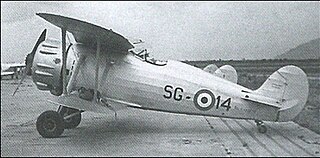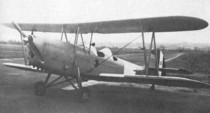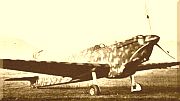Related Research Articles

The Fokker C.V was a Dutch light reconnaissance and bomber biplane aircraft manufactured by Fokker. It was designed by Anthony Fokker and the series manufacture began in 1924 at Fokker in Amsterdam.

The Caproni Ca.314 was an Italian twin-engine monoplane bomber, used in World War II. Derived from the similar Ca.310, it was used for ground-attack and torpedo bomber duties. It was the most extensively built Ca.310 derivative, and included bomber, convoy escort/maritime patrol, torpedo bomber, and ground-attack versions.

The Meridionali Ro.37 Lince was a two-seater Italian reconnaissance biplane, a product of the Industrie Meccaniche Aeronautiche Meridionali (IMAM) company. It appeared in 1934 and had a composite structure of wood and metal. The aeroplane first saw operational duty in the Second Italo-Ethiopian War (1935–1936) and Spanish Civil War (1936–1939), and during the Second World War it saw duty on almost all fronts, except for Russia and the English Channel. It followed the Ro.1 as the main reconnaissance aircraft for the Italian Army.

The Caproni Ca.309 Ghibli was an Italian aircraft used in World War II. Its nickname 'Ghibli' refers to a desert wind and later served as the inspiration for animation Studio Ghibli's name.

The Caproni Ca.135 was an Italian medium bomber designed in Bergamo in Italy by Cesare Pallavicino. It flew for the first time in 1935, and entered service with the Peruvian Air Force in 1937, and with the Regia Aeronautica in January 1938.

The Caproni Ca.100 was the standard trainer aircraft of the Regia Aeronautica in the 1930s. Large numbers of this tandem, two-seat, biplane were built, powered by different engines.

The Caproni Vizzola F.5 was an Italian fighter aircraft built by Caproni. It was a single-seat, low-wing cantilever monoplane with retractable landing gear.

The IMAM Ro.41 was an Italian light biplane fighter aircraft, serving in the Regia Aeronautica in the 1930s-1940s, mainly as a trainer.

The IMAM Ro.63 was an Italian STOL aircraft designed for short-range reconnaissance and light transport during World War II.

The IMAM Ro.57 was an Italian twin-engined, single-seat monoplane fighter of the Regia Aeronautica. Based on a 1939 design by Giovanni Galasso the aircraft did not enter production until 1943.

The Caproni Ca.164 was a training biplane produced in Italy shortly prior to World War II. It was a largely conventional biplane intended as a follow-on to the Ca.100 and sharing that aircraft's layout with a slightly smaller upper wing.

The Caproni Ca.311 was a light bomber-reconnaissance aircraft produced in Italy prior to and during World War II. It was a member of the large family of Caproni designs derived from the Ca.306 airliner prototype of 1935, and more directly a modification of the Ca.310 bomber. As with other related types, it was a low-wing cantilever monoplane of conventional design. This particular design incorporated the Ca.310's retractable main undercarriage, as well as the heavily glazed nose that had been tested on the Ca.310bis prototype. New features included a relocation of the dorsal turret to a position immediately aft of the cockpit, and additional glazing throughout the fuselage.

The Caproni Vizzola C22 Ventura was a light jet-powered aircraft developed in Italy for use as a military trainer. It was of conventional sailplane configuration and bore a family resemblance to the Caproni Calif gliders, although the Ventura had an almost entirely metal structure. The student and instructor sat side by side under an expansive canopy, and weapons hardpoints were provided under each of the slender, high-mounted wings. It had retractable, tricycle undercarriage.

The SAIMAN 200 was a 1930s Italian two-seat primary trainer designed and built by the Società Industrie Meccaniche Aeronautiche Navali (SAIMAN).

The IMAM Ro.5 was a sport aircraft produced in Italy in the late 1920s. It was a conventional, parasol wing monoplane with fixed tailskid undercarriage and two open cockpits in tandem. It proved popular with private owners and flying clubs, and was built in large numbers. Some Ro.5s were purchased by the Regia Aeronautica for use as trainers and liaison aircraft. A later version, the Ro.5bis, enclosed the cockpits under a long canopy.

The Caproni Vizzola F.4 was an Italian fighter aircraft prototype designed and built from 1939. It was a single-seat, low-wing cantilever monoplane with retractable landing gear.

The Caproni Vizzola F.6 was a World War II-era Italian fighter aircraft built by Caproni. It was a single-seat, low-wing cantilever monoplane with retractable landing gear. Only two prototypes were built, one designated F.6M and the other designated F.6Z.

The Caproni Ca.335 Maestrale (Mistral) was an Italian single-engined two-seat fighter-bomber/reconnaissance aircraft of the 1930s.

The Caproni Ca.193 was an Italian liaison and air-taxi aircraft that was offered to the Italian Air Force as an instrument flight trainer and to the Navy for liaison. Design work started in 1945 and only the prototype was built. It was the last aircraft the Caproni company designed and built in Milan.
The Caproni Ca.142 was a three-engined multirole aircraft built by Caproni in the mid-1930s.
References
- 1 2 3 de Toni, Adriano. "Caproni AV.I.S. C.4" (in Portuguese). Brazil: www.deadlybirds.com. Archived from the original on 9 February 2012. Retrieved 10 February 2012.